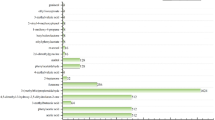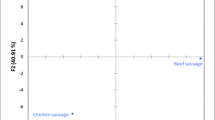Abstract
YE (yeast extract) has been widely used in the flavor industry as the source to produce the high-quality meaty and umami flavors. It is because YE is rich in the savory and mellow constituents and is important precursors to generate aromas via thermal treatment. This study aims to investigate the change of meaty aroma and umami taste in the hydrolyzed YE during the thermal treatment. In this study, gas chromatography–olfactometry-mass spectrometer (GC-O-MS) was employed to detect the aroma-active compounds, and systematic approaches was used for the taste-active umami proteolytics separation and detection. The reaction conditions of two optimal samples, YE-A and YE-B, were as follows: the reaction time (A) was 90 min, the reaction temperature (B) was at 115 °C, the concentration of YE solution (C) was 0.4 g/mL, and pH (D) was 5.5 and 6.0, respectively. The GC-O-MS results show YE-A contains 31 and YE-B contains 29 key aroma-active compounds, and the priorities of four factors are both C > B > D > A. The key aroma-active compounds that contributed to meaty flavor were both 3-(methylthio)propanal (cooked potato-like), dihydro-5-pentyl-2(3H)-furanone (coconut-like, peach-like), 2-ethyl-3,5-dimethyl pyrazine (potato-like) etc. with OAVs greater than 1. The Q-TOF–MS/MS results show that YE-A contained five umami peptides, which were Ala-Asp-Ala, Pro-Gly-Asp, Glu-Met-His, Gln-Pro-Ser and Val-Glu-His; whereas YE-B contained four umami peptides, which were Glu-Asp, Pro-Ser-Gly, Ala-Glu-Ala, and Gly-Gly-Pro-Gly.




Similar content being viewed by others
Abbreviations
- YE:
-
Yeast extract
- MSG:
-
The orthogonal experiment; monosodium glutamate
- GC-O-MS:
-
Gas chromatography–olfactometry-mass spectrometry
- SIDA:
-
Stable isotope dilution assays
- UF:
-
Ultrafiltration
- GPC:
-
Gel permeation chromatography
- RP-HPLC:
-
Reverse-phase high-performance liquid chromatography
- UPLC-TOF–MS/MS:
-
Ultra-performance liquid chromatography combined with time-of-flight mass spectrometry
- OAVs:
-
Odor activity values
- TAVs:
-
Taste activity values
References
Chae HJ, Joo H, In MJ (2001) Utilization of brewer’s yeast cells for the production of food-grade yeast extract. Part 1. Effect of different enzymatic treatments on solid and protein recovery and flavor characteristics. Bioresour Technol 76:253–258. https://doi.org/10.1016/s0960-8524(00)00102-4
Alim A, Song HL, Liu Y, Zou TT, Zhang Y, Zhang SP, Raza A (2019) Research of beef-meaty aroma compounds from yeast extract using carbon module labeling (CAMOLA) technique. LWT Food Sci Technol 112:108–239. https://doi.org/10.1016/j.lwt.2019.06.006
Toelstede S, Dunkel A, Hofmann T (2009) A series of kokumi peptides impart the long-lasting mouthfulness of matured Gouda cheese. J Agric Food Chem 57(4):1440–1448. https://doi.org/10.1021/jf803376d
Kim MJ, Son HJ, Kim Y, Misaka T, Rhyu M (2015) Umami-bitter interactions: the suppression of bitterness by umami peptides via human bitter taste receptor. Biochem Biophys Res Commun 456:586–590. https://doi.org/10.1016/j.bbrc.2014.11.114
Chen HT, Xu XL, Zhang N, Sun BG, Wang H (2013) Optimal chicken enzym atic hydrolysate for the preparation of chicken flavoring. Food Sci (China) 34(9):150–154. https://doi.org/10.7506/spkx1002-6630-201309031
Alim A, Song HL, Liu Y, Zou TT, Zhang Y, Zhang SP (2018) Flavor-active compounds in thermally treated yeast extracts. J Sci Food Agric 98(10):3774–3783. https://doi.org/10.1002/jsfa.8891
Zhang Y, Song HL, Li P, Yao J, Xiong J (2017) Determination of potential off-flavour in yeast extract. LWT Food Sci Technol 82:184–191. https://doi.org/10.1016/j.lwt.2017.04.030
Zhuo L, Wang QX, Jin DZ, Tao F, Chi TH, Shi QS (2020) Characterization of aroma-active compounds in four yeast extracts using instrumental and sensory techniques. J Agric Food Chem. https://doi.org/10.1021/acs.jafc.9b06751
Aaslyng MD, Martens M, Poll L et al (1998) Chemical and sensory chractrization of hydrolyzed vegetable protein, a savory flavoring. J Agric Food Chem 46:481–489. https://doi.org/10.1021/jf970556e
Lin ML, Liu XS, Xu QQ, Song SHL (2014) Aroma-active components of yeast extract pastes with a basic and characteristic meaty flavour. J Sci Food Agric 94(5):882–889. https://doi.org/10.1002/jsfa.6330
Zhang YF, Hoon MA, Jayaram C et al (2003) Coding of sweet, bitter, and umami tastes: different receptor cells sharing similar signaling pathways. J Cell Sci 112(3):293–301. https://doi.org/10.1016/s0092-8674(03)00071-0
Toelstede S, Hofmann T (2008) Quantitative studies and taste re-engineering experiments toward the decoding of the nonvolatile sensometabolome of Gouda cheese. J Agric Food Chem 56:5299–5307. https://doi.org/10.1021/jf800552n
Lee HJ (2001) His-His-Leu, an angiotensin I converting enzyme inhibitory peptide derived from Korean soybean paste, exerts antihypertensive activity in vivo. J Agric Food Chem 49(6):3004–3009. https://doi.org/10.1021/jf001135r
Methven L (2012) Natural food and beverage flavour enhancers. Woodhead Publishing Limited, Sawston, pp 76–95
Schlichtherle-Cerny H, Amadò R (2002) Analysis of taste-active compounds in an enzymatic hydrolysate of deamidated wheat gluten. J Agric Food Chem 50(6):1515–1522. https://doi.org/10.1021/jf010989o
Alim A, Yang C, Song HL, Liu Y, Zou TT, Zhang Y, Zhang SP (2018) The behavior of umami components in thermally treated yeast extract. Food Res Int 120:534–543. https://doi.org/10.1016/j.foodres.2018.11.002
Zellner BD, Carolina A, Amorim L, Luisa A, Rezende MC (2009) Screening of the odour-activity and bioactivity of the essential oils of leaves and flowers of Hyptis Passerina Mart. from the Brazilian Cerrado. J Braz Chem Soc 20(2):322–332. https://doi.org/10.1590/S0103-50532009000200018
Liu JB, Liu MY, He CC, Song HL, Chen F (2015) Effect of thermal treatment on the flavour generation from Maillard reaction of xylose and chicken peptide. LWT Food Sci Technol 64:316–325. https://doi.org/10.1016/j.lwt.2015.05.061
Burdock GA (2009) Fenaroli's handbook of flavor ingredients, 6th edn. CRC Press, Cambridge (ISBN 10: 9781420090772)
Rychlik M, Schieberle P, Grosch W (1998) Compilation of odor thresholds, odor qualities and retention indices of key food odorants. Technischen Universität München, Garching
Alim A, Song HL, Liu Y, Zou TT, Zhang Y, Zhang SP (2019) Variation of Umami Taste and Identification of Umami Peptides during thermal treatment of yeast extract. Food Sci (China) 40(3):9–15. https://doi.org/10.7506/spkx1002-6630-20180123-306
Yang C, Wang R, Song HL (2012) The mechanism of peptide bonds cleavage and volatile compounds generated from pentapeptide to heptapeptide via Maillard reaction. Food Chem 133(2):373–382. https://doi.org/10.1016/j.foodchem.2012.01.044
Liu JB, Song HL, Liu Y, Li P, Yao J, Xiong J (2015) Discovery of kokumi peptide from yeast extract by LC-Q-TOF-MS/MS and sensomics approach. J Sci Food Agric 95:3183–3194. https://doi.org/10.1002/jsfa.7058
Alim A, Song HL, Liu Y, Zou TT, Zhang Y, Zhang SP (2019) Changes in the perception of bitter constituents in thermally treated yeast extract. J Sci Food Agric 99:4651–4658. https://doi.org/10.1002/jsfa.9705
Tamura M, Nakatsuka T, Tada M, Kawasaki Y, Kikuchi E, Okai H (1989) The relationship between taste and primary structure of “delicious peptide” (Lys-Gly-Asp-Glu-Glu-Ser-Leu-Ala) from beef soup. Agric Biol Chem 53(2):319–325. https://doi.org/10.1080/00021369.1989.10869317
Kuramitsu R, Takahashi M, Tahara K, Nakamura K, Okai H (1996) Tastes produced by peptides containing ionic groups and by related compounds. Biosci Biotechnol Biochem 60:1637–1642. https://doi.org/10.1271/bbb.60.1637
Acknowledgements
This study is financially supported by National Natural Science Foundation of China (NSFC) Project (31571884).
Author information
Authors and Affiliations
Corresponding authors
Ethics declarations
Conflicts of interest
We all authors (Aygul Alim, Huanlu Song, Tingting Zou) of this article declare that we have no confilict of interest.
Compliance with ethics requirements
This article does not contain any studies with human or animal subjects.
Additional information
Publisher's Note
Springer Nature remains neutral with regard to jurisdictional claims in published maps and institutional affiliations.
Rights and permissions
About this article
Cite this article
Alim, A., Song, H. & Zou, T. Analysis of meaty aroma and umami taste in thermally treated yeast extract by means of sensory-guided screening. Eur Food Res Technol 246, 2119–2133 (2020). https://doi.org/10.1007/s00217-020-03561-5
Received:
Revised:
Accepted:
Published:
Issue Date:
DOI: https://doi.org/10.1007/s00217-020-03561-5




